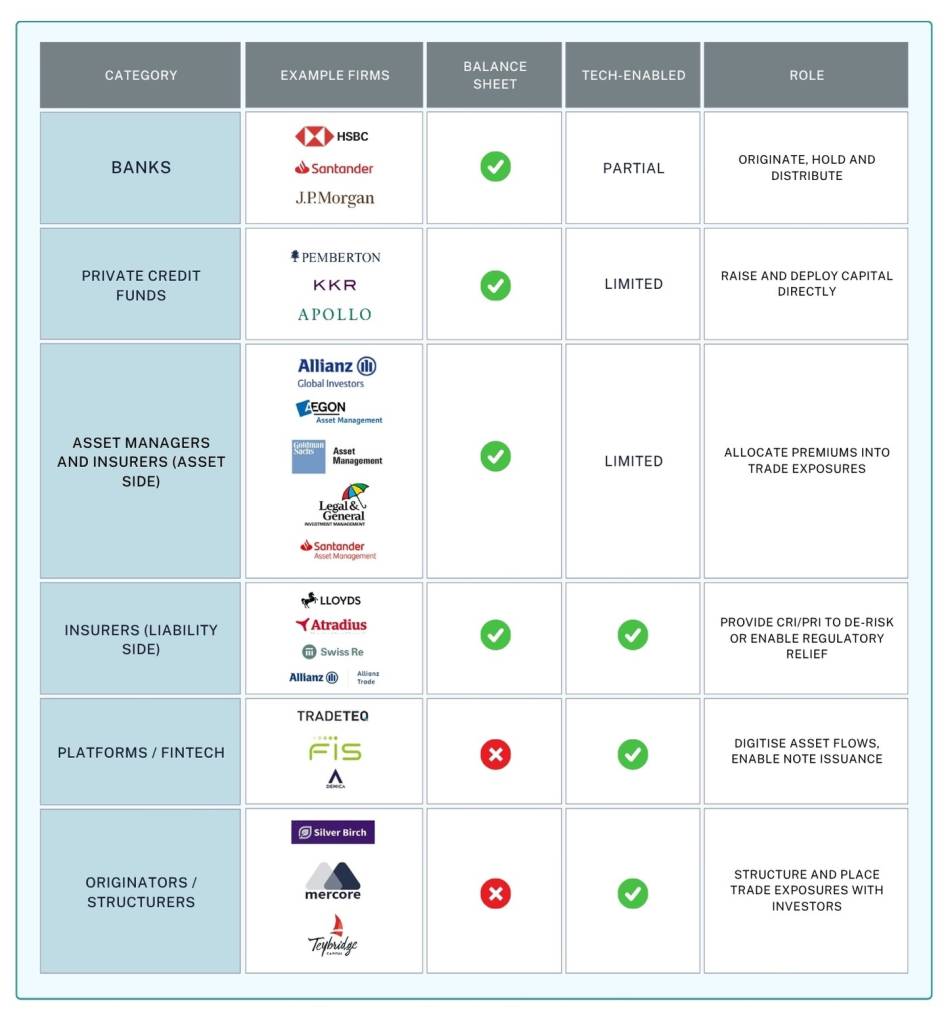AI-generated fraud: The next great threat in trade finance
Carter Hoffman
Jun 27, 2025
 Deepesh Patel
Jun 27, 2025
Deepesh Patel
Jun 27, 2025

Trade finance has long been seen as the steady, under-the-radar cousin of corporate lending – predictable and asset-backed, yet rarely headline-grabbing. Over the past decade, however, it has started to evolve into a bankable, investable, and increasingly tradable asset class.
That evolution has largely come from infrastructure; more specifically, from a new ecosystem of players redesigning how trade credit gets originated, structured, and syndicated.
This is a story about the changing financial landscape of how capital flows into the real economy.
Let’s start with the traditional model. Banks have always been the backbone of trade finance. They provide working capital via letters of credit, receivables discounting, supply chain finance (SCF), and inventory-backed loans, most of which sits on their balance sheet, often they are short-term, in nature with an identified source of repayment.
But increasingly, those exposures are being structured and distributed in more capital-efficient ways. Think master risk participation agreements (MRPAs) that allow banks to offload risk and exposures while retaining the relationship, insurance-wrapped receivables that reduce capital charges under Basel, or SCF programmes where the bank advances early payment to suppliers based on buyer creditworthiness, then sells down the risk.
The goal is almost universally to optimise return on risk-weighted assets (RWA) or return on equity (RoE) and keep trade flowing, without overburdening the balance sheet.
Yet post-2008, that balance sheet has become a more expensive place to house anything that isn’t investment grade, standardised, and short-dated. Inventory finance, for example, attracts a 100% risk weight, even when backed by physical goods and with Basel 3.1 potentially pushing for higher capital requirements by implementing the output floor, banks are reassessing which trade assets to hold, and which to originate and distribute.
Enter the non-bank liquidity providers. Over the past five years, private credit funds, family offices, and insurance mandates have poured into trade and working capital finance.
Some funds operate like direct lenders, underwriting corporate receivables and inventory lines while others act more like Limited Partners (LP) investors, taking senior or mezzanine tranches in already-originated pools. Some large asset managers (like LGIM or GSAM) allocate capital to fund originators, sourcing yield and ESG alignment through trade-linked exposures.
What they all share is a need for assets in a packaged form that is legally transferable to investors. These investors don’t want hundreds of fragmented bilateral deals. They want rated, tranchable, and auditable assets, packaged with consistent onboarding, documentation, and performance data.
But the challenge is that most trade finance still isn’t built that way.
Securitisation in trade has historically been difficult since the assets are short-term and operationally complex from a processing and servicing perspective. Diverse legal frameworks and the fact that originators are often SMEs or corporates without standardised data trails compound this.
Despite all of the surrounding challenges, securitisation is becoming more relevant, largely because it’s the only way to pool and tranche exposures into investable units that can be rated, sold, and slotted into a private debt, insurance, or ABS mandate, to meet differing investor risk appetites.
At the same time, banks and insurers are increasingly constrained by capital and regulation. A properly structured securitisation, especially with credit insurance or external ratings, can provide regulatory capital relief, funding, limit and exposure relief, and customisation for yield and risk appetite.
This is where the bottleneck lies. Originating a trade finance asset is one thing, but turning it into a form that an institutional investor can buy (and a regulator can approve) is another.
Achieving that aim requires onboarding the corporate and conducting KYC/AML, standardising data and documentation, packaging assets into SPVs or note structures, adding credit enhancement (insurance, overcollateralisation, tranching), and distributing through a broker, platform, or direct investor channel
Needless to say, that can be a slow, legal-heavy, and expensive process.
However, that challenge creates opportunity and what we’re beginning to see in the industry is a middle layer of originators and structuring boutiques that sit between the corporate and the capital. These new firms do the heavy lifting (like structuring, onboarding, and matching deals to investors) without taking credit risk themselves.
In May, Silver Birch, a working capital structuring, inventory solutions and advisory group, acquired Tradeteq, a technology firm specialising in trade finance asset distribution and securitisation. This acquisition is a good illustration of the securitisation trend in practice. Too see why, let’s take a deeper look into the background of the firms involved.
Silver Birch, founded in 2020 and backed by TDR Capital, has built a reputation as a balance-sheet-light structurer. It doesn’t lend directly or hold risk but originates and structures working capital transactions (often with mid-market corporates) as well as inventory solutions and arranges funding through a syndicate of banks, funds, and insurers.
The firm’s model is tailored for a post-Basel environment. Providing inventory solutions as the owner of goods, for example, has become prohibitively capital-intensive for banks to carry. A 100% risk weight under current Basel rules, plus heightened operational and legal friction, means many banks either decline to participate or prefer to offload such risk as quickly as possible. Silver Birch Trading steps into this gap, structuring deals via its group of “TradeCos” which buy, own and sell goods to optimise procurement and sales for its corporate clients. These TradeCos then fund themselves working in partnership with banks and other capital providers who are willing to hold the client credit risk.
What makes Silver Birch different from a private credit fund is that it doesn’t take principal funding risk. It’s not deploying a fund or managing a pool of investor capital. Instead, it is an arranger, similar in some ways to a boutique investment bank, but focused entirely on trade finance, inventory solutions and receivables-linked structures. The team originates real economy exposures, manages documentation, and structures the exposures for distribution, whether to a bank under a master participation agreement, to a fund via bilateral financing, or to an insurance company
That’s where Tradeteq comes in. Founded in 2016, Tradeteq built a platform designed to bring capital markets infrastructure to the trade finance world, digitising the process of packaging receivables into investable securities. Originators can use the Tradeteq technology stack to upload trade asset structure securitisations and notes issuance via Luxembourg SPV that can be sold to institutional investors. The platform supports credit analysis and real-time portfolio reporting, and secondary trading, all of which lower the barrier for non-bank capital to enter the space. For Silver Birch, the acquisition provides potential for a ready-made securitisation and distribution layer that allows it to scale its structuring model without having to build proprietary technology from scratch.
Silver Birch already structures multi-jurisdictional, multi-obligor transactions. By combining this structuring capability with Tradeteq’s digital platform, it has now placed close to $7 billion of funding across the group, with the tools to offer notes issuance, risk transfer, and regulatory capital relief, while remaining balance-sheet-light. For institutional investors, that means better access to enhanced trade assets while for banks, it opens up a pathway to de-risk while still originating and for corporates, it means continued access to trade finance without depending solely on bank appetite.
By staying balance-sheet-neutral and investing in infrastructure and expertise rather than assets, Silver Birch and Tradeteq are positioning themselves as facilitators in a market that’s steadily becoming more capital-efficient and marketable.
Their success won’t be measured in volume alone. It will depend on whether they can standardise what remains deeply bespoke, and whether institutional investors ultimately trust this new layer of distribution. But for a sector that’s long struggled with scalability, that’s a bet worth watching.
Understanding the Ecosystem
Here’s how it all fits together:

Trade finance is being rebuilt from the inside out. What we’re witnessing is the professionalisation of an asset class where format matters as much as fundamentals.
The winners will be the ones who understand how to connect origination to allocation, legally, digitally, and repeatably.
That’s what Silver Birch and Tradeteq are trying to do. But they’re not alone, and they don’t need to be.
Trade Treasury Payments is the trading name of Trade & Transaction Finance Media Services Ltd (company number: 16228111), incorporated in England and Wales, at 34-35 Clarges St, London W1J 7EJ. TTP is registered as a Data Controller under the ICO: ZB882947. VAT Number: 485 4500 78.
© 2025 Trade Treasury Payments. All Rights Reserved.